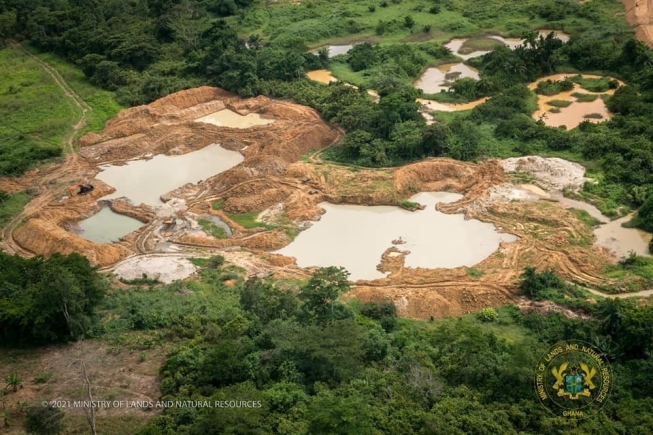
Galamsey may cause catastrophic shifts in Ghana’s ecosystems
Ghana is currently facing an economic crisis, but also a potential ecological disaster that will test its resilience in ways we may have never seen before.
That’s a double whammy. How resilient a society is, and how well and soon it may recover from severe shocks is a subject that has been dealt with in the study of “complex systems”.
In the domain of complex systems, there are three key concepts of note. These are: critical transitions, tipping points and catastrophic shifts.
Marten Scheffer, an ecologist and professor at Wageningen University in the Netherlands and one of the world's pre-eminent authorities on the subject of complex systems, has produced a huge body of scholarly work on this subject.
What we have learnt from Marten Scheffer's work and those of others is that, for complex systems that are approaching a tipping point or that are about to undergo critical transitions, there are often early-warning signals.
Scheffer and his colleagues, in their 2003 essay published in the journal Ecosystems and titled “Slow response of societies to new problems: causes and costs”, have asserted among others that “…societies that are systematically slow in suppressing problems in the early phases will pay a high overall cost.”
They further noted that for such societies, “even if a problem is generally recognised, actual regulation may come late”, and suggested that “this last phase of delay tends to be longer if a central decision-making authority is lacking and if disproportionately powerful stakeholders that benefit from the unregulated status quo are involved.”
Ecological integrity
Today, Ghana appears to be headed for what may be a large-scale loss of its ecological integrity, enabled by large-scale illegal mining, so-called "galamsey".
Yet, there is the presumption that when a system is disturbed by shocks, it may just bounce back after some time.
Thus, in some quarters, it is assumed that the ongoing large-scale pollution and destruction of Ghana’s ecosystems – water bodies, agricultural soils, forests and grasslands, and even our human bodies which may now be ingesting poisonous chemicals regularly – may not be that alarming, and that these systems have the ability to undergo some degree of self-cleansing whenever the destructive events have been put on hold.
This may be contributing to the inertia in dealing with the problem squarely.
Unfortunately, the above assumption is only partly true, because whether a system can recover from shocks or not is governed by the theory of resilience thresholds.
That is, there is often a degree of disturbance that a system can tolerate, beyond which it will enter a phase of critical transition, followed by a catastrophic shift which may perpetually alter its character.
A key concept in ecology – the study of the interactions between organisms and their physical environment – is that in some ecosystems, there are the so-called keystone species, which are often few but have a disproportionately large effect on the habitats in which they live.
And when these keystone species are removed from their habitat, the habitat undergoes a cataclysmic collapse, because these keystone species influence how well the other components of the system function.
To better understand this concept, one may look to a somewhat controversial example. When Libya’s long-time leader Muammar Gaddafi was killed in 2011, Libya became a nation whose territorial integrity has since been threatened, faced with ongoing humanitarian and political crises.
Surely, this essay is not necessarily an endorsement of so-called authoritarian regimes.
Instead, this analogy only serves to drum home the point that in ecosystems, there are a few species that may control the efficient functioning of the entire system, and their removal, if not carefully planned, would automatically lead to the tumbling down of the entire system—an ecosystem collapse.
How then may the ongoing “galamsey” crisis lead to an irrevocable loss of Ghana’s ecological integrity?
When we consider the negative effects of “galamsey”, we are often moved by the dramatic colour changes our water bodies have assumed, and how heavy metals deployed in “galamsey” activities poison our environment, then enter our food chain and end up on our dining tables, leading to health/organ failures upon consumption. This is a tragedy.
But more than that, we may also imagine that in the forests, grasslands, and water bodies that are being destroyed in the name of “galamsey”, there may be rare species of plants and animals and other organisms that may be lost forever.
Some of these may hold clues to the cures for human diseases for which there are currently no cure. Importantly, some may function as keystone species, and the destruction of the environment in which they live, or their direct annihilation, can only lead to one thing – a catastrophic shift in the character of our ecosystems, ultimately for the worse.
Thus, Ghana is clearly now at the precipice of ecological catastrophe. But we keep our eyes on the proposed rescue plans (if they in fact exist), and hope that they turn out well.
Surely, this country – the only place on Earth many of us may call home – which appears to be getting damaged at its core, must urgently save itself.
The writer is a scientist at the University of Cape Coast.
E-mail: iagorsor@ucc.edu.gh
